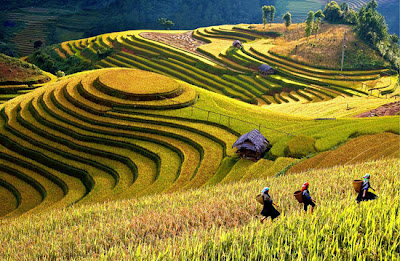Stilt
houses scattered around Pa Phach 2 Hamlet in Moc Chau District in Son La
Province
I
had dreamt of visiting Moc Chau District in Son La Province with my friends one
weekend to see its world-famous flowers and finally it came true.
We
decided to take the late bus from My Dinh Station in Hanoi at 7:30 p.m. and
when we finally arrived at Moc Chau at around 2 a.m., the town was still
soundly sleeping and streets corners were quiet and peaceful in the mist and
darkness.
We
had booked in advance our accommodation at a stilt house in an eco-tourist area
and arrived in the room in the chill of the mountainous region. Through the
windows, we could barely see deeply winding trails in the distant mist.
After
a short sleep, we were up at the crack of dawn to start our journey to Pa Phach
hamlets. With five motorbikes hired at VND150,000 each, we were keen to conquer
the rocky and tortuous roads which looked rather adventurous with a rocky
mountain on one side and deep valley on the other.
We
conquered our obvious fear and discovered that the nature we experienced would
stay in our hearts forever.
Firstly,
we looked to see an immense greenness of plum trees appearing before us. It
looked like a green carpet, stretching into the horizon as it was studded with
stilt houses of ethnic people. I thought about the ancient times, primitive
times, magnificence, endless nature and romance of the trip in this moment.
Along
the journey, we saw ethnic women with wooden packs on their backs in slow steps
and austere faces. We could also not forget the kids’ glowing red cheeks as
well as pigs tramping around.
We
just moved, up and down through hills and took many photos between big groves
of plum trees which combined together as domes in palaces amidst white radish
farms and peach blossom flowers.
At
noon, we stopped for lunch. I started to imagine the images of barbarians
eating in the jungle in comic books or cartoons.
We
moved on to Moc Chau tea plantation. We totally lost ourselves amidst the giant
plateau that is green tea hills and grass covers for cattle.
We
shouted for joy when seeing a white cabbage flowers. Cabbage flowers are small,
fragile and swinging in the wind, they apparently touch a girls’ soul.
Time
went by quickly and the sunset started to come on the plateau. We were now in a
hurry to go to the hotel.
On
the next day, we discovered Dai Yem Waterfall and a pine hill. Not very big or
high, the waterfall is charming due to its gentle stream, glistening sunbeams
over its spumes and by the many colorful wild flowers around it.
Passing
the pine hill, we indulged in the romantic scenery with pine trees shaking in
the wind and small lake reflecting the sun rays and our happy faces. The
setting reminded us of Dalat.
Moc
Chau is 190 kilometers from Hanoi. To get there, tourists can take a motorbike
trip from Nguyen Trai Street in Hanoi then along National Road No.6. The roads
are easy but travelers should choose a sunny day to be safe.




